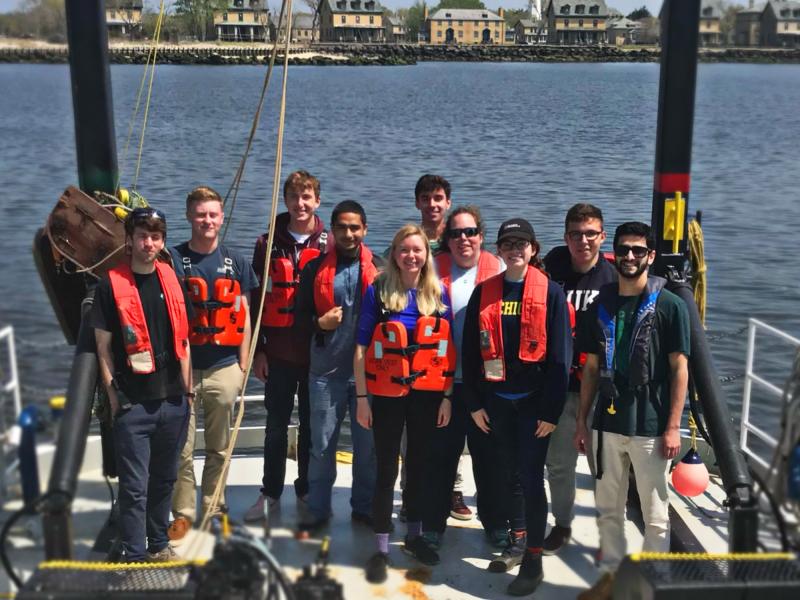What Is eDNA?
Have you ever wondered what fish lurk below the ocean’s surface? With increasing human demand for ocean resources, it’s important to have many ways to track living marine resources in the ocean. A study published in Environmental DNA combines field and laboratory data to better understand environmental DNA, or eDNA, for three key fish species.
Fishery scientists can use eDNA to measure the biodiversity, or the amount and species of fish in a habitat. From scales to waste, eDNA is constantly shed by ocean animals. Scientists can collect eDNA in a non-invasive and efficient way by taking water samples.
The paper was written by NOAA Fisheries Howard Lab researchers Daniel Wieczorek and Thomas Noji and collaborators from:
- SUNY Buffalo
- Marine Academy of Science and Technology
- University of San Francisco
Filling in the Knowledge Gaps
“There was a lack of controlled lab experiments in eDNA research. We decided to fill that research gap,” says Wieczorek.
Combining eDNA lab experiments with traditional surveying methods offers more information on the presence, amount, and location of fish. This study uses recirculating aquaculture systems, trawl surveys, and genetic sequencing to enhance data from traditional survey methods.
Using black sea bass, winter flounder, and summer flounder—all species found on the New Jersey coast—scientists estimated the rate that eDNA sheds from animals and decays. “A good understanding of decay and production rates makes eDNA a more valuable monitoring tool,” Noji says, highlighting that these rates can help scientists detect what and when species are present.
Recirculating aquaculture systems are controlled indoor systems consisting of filtration, water reserves, and fish tanks. The system for this study has six tanks and is located at the James J. Howard Laboratory. With the eDNA collected in water samples, our partners at SUNY Buffalo used quantitative polymerase chain reaction assays, a technology that measures DNA. They calculated eDNA shedding and decay rates for the three commercially important fish species named above. This study contributes to the growing eDNA library we use to identify species. Noji and Wieczorek continue to help develop NOAA's Fisheries Strategic Initiative to use eDNA libraries.
Working with the Marine Academy of Science and Technology and annual NOAA trawl surveys, we conduct fish surveys and water sampling in Sandy Hook Bay. These surveys include:
- Ecosystem Monitoring Program
- Fall Bottom Trawl
- Atlantic Marine Assessment Program for Protected Species
In areas that are hard to survey with traditional fishing gear, eDNA may become a useful tool for informing and improving stock assessment.
How eDNA Can Help Our Oceans
“It’s really exciting to bring to reality a ‘space-agey’ type tool with tremendous potential. eDNA technology can augment traditional surveys and provide data that previously weren’t captured,” says Wieczorek.
Quick and cost effective, eDNA is an efficient tool that provides a snapshot of ecosystems beneath the waves.
“eDNA patterns tell a lot about change in communities over time. This can be applied to understanding human impact on climate change,” says Noji.
Environmental DNA is also important for monitoring endangered, rare, and invasive species that are hard to locate. “For a resilient ecosystem, we need to ensure biodiversity. Over the past 20 years, scientists have been collecting and freezing DNA samples. Using eDNA technology, we can look at old samples and be able to see fast changes in the ecosystem,” says Kirtane.
A non-invasive and efficient tool, eDNA can accurately assess biodiversity and inform management decisions to protect our marine resources. Future eDNA studies will help scientists develop these techniques and make more accurate and effective recommendations for fisheries management and preservation.
Working with Partners
“Collaboration was absolutely essential for this study. The partnerships go a lot further than this publication,” says Wieczorek. “Workshopping and brainstorming with partners brought different thoughts and experiences together. That’s what led to such a great collaborative relationship.”
“This new line of eDNA research created an avenue for new staff to join the lab. It was a nice opportunity for students and researchers to participate in new research,” says Noji. First author Anish Kirtane used this study for his masters thesis from SUNY Buffalo. He is now collaborating on a global eDNA database as a doctoral student at ETH Zurich, a prestigious research university. High school students from MAST helped conduct eDNA research and became co-authors on a scientific paper. This study is a prime example of how research can support both science and outreach initiatives.






